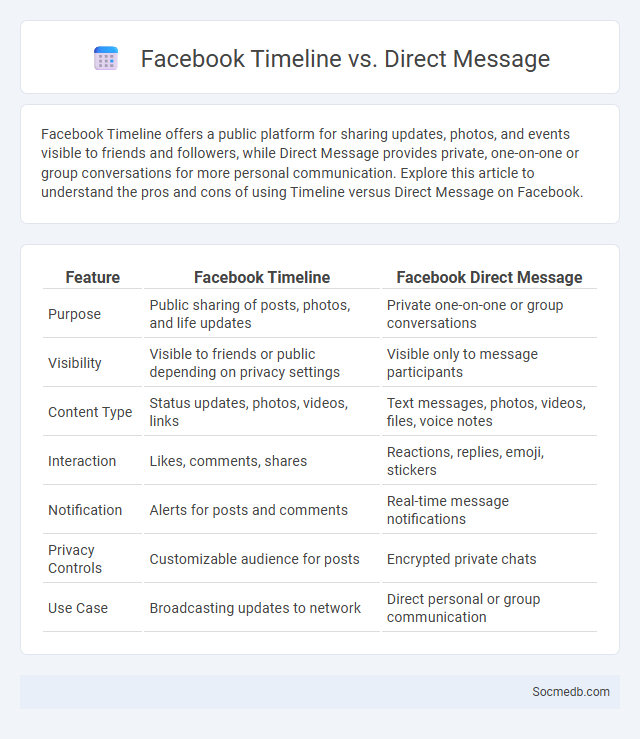
Photo illustration: Facebook Timeline vs Direct Message
Facebook Timeline offers a public platform for sharing updates, photos, and events visible to friends and followers, while Direct Message provides private, one-on-one or group conversations for more personal communication. Explore this article to understand the pros and cons of using Timeline versus Direct Message on Facebook.
Table of Comparison
| Feature | Facebook Timeline | Facebook Direct Message |
|---|---|---|
| Purpose | Public sharing of posts, photos, and life updates | Private one-on-one or group conversations |
| Visibility | Visible to friends or public depending on privacy settings | Visible only to message participants |
| Content Type | Status updates, photos, videos, links | Text messages, photos, videos, files, voice notes |
| Interaction | Likes, comments, shares | Reactions, replies, emoji, stickers |
| Notification | Alerts for posts and comments | Real-time message notifications |
| Privacy Controls | Customizable audience for posts | Encrypted private chats |
| Use Case | Broadcasting updates to network | Direct personal or group communication |
Understanding Facebook Timeline: A Public Sharing Space
Facebook Timeline serves as a dynamic public sharing space where users chronologically display posts, photos, and life events visible to friends or the public depending on privacy settings. This feature organizes content in a linear format, allowing easy access to a user's social history, interactions, and shared media over time. Understanding Facebook's Timeline is essential for managing online presence, controlling audience visibility, and enhancing social engagement strategies.
What Is Facebook Direct Message?
Facebook Direct Message is a private messaging feature within Facebook that allows you to send instant, one-on-one or group messages directly to friends or contacts. Your conversations remain confidential and can include text, images, videos, links, and voice notes for seamless communication. This tool enhances your social networking experience by providing a secure and efficient way to stay connected beyond public posts.
Timeline vs Direct Message: Key Differences
Timeline posts on social media allow your audience to see and interact with content publicly, fostering broad engagement and community building. Direct Messages (DMs) provide a private communication channel, enabling personalized, one-on-one conversations without public visibility. Understanding the key differences between Timeline and Direct Messages helps you tailor your social media strategy for either wide-reaching impact or confidential dialogue.
Privacy Levels: Timeline Posts vs DMs
Social media platforms offer distinct privacy levels for timeline posts compared to direct messages (DMs), with timeline posts generally being visible to a broader audience based on user-defined settings such as public, friends-only, or custom lists. Direct messages provide a higher degree of privacy, as conversations are typically encrypted and restricted to the participants involved. Understanding these privacy hierarchies is crucial for managing personal information and controlling audience reach effectively on platforms like Facebook, Instagram, and Twitter.
Content Types: What to Share on Timeline vs DM
Sharing diverse content types on your social media timeline, such as informative articles, engaging videos, and eye-catching images, boosts public interaction and broadens your audience reach. Direct messages are ideal for personalized content like exclusive offers, private event invitations, or customer support to foster deeper connections and prompt immediate responses. Tailoring your content strategy to these platforms enhances your marketing effectiveness and ensures your message resonates appropriately.
Engagement: Reactions and Responses Compared
User engagement on social media platforms is measured primarily through reactions such as likes, loves, and emojis, which indicate immediate emotional responses. Comments and shares represent deeper interaction levels, fostering conversations and content dissemination across networks. Analyzing these metrics helps marketers optimize campaigns by targeting content that maximizes user interaction and community building.
Use Cases: When to Post and When to Message
Optimal social media use cases involve timing posts for peak engagement, such as during early mornings, lunch breaks, and evenings when users are most active. Messaging should be reserved for direct, personalized interactions like customer inquiries, support, and follow-ups to drive conversions and loyalty. Employing analytics tools to analyze audience behavior enhances the effectiveness of both posting schedules and messaging strategies.
Security Considerations: Public vs Private Communication
Social media platforms present distinct security considerations for public versus private communication, with public posts being accessible to a broad audience, increasing the risk of data breaches and identity theft. Private messages, while more secure, remain vulnerable to hacking, phishing, and unauthorized access if users lack strong passwords or two-factor authentication. Understanding privacy settings and employing encryption tools are essential practices to safeguard sensitive information in both communication modes.
User Control: Managing Posts and Private Chats
You have full control over managing your posts and private chats on social media platforms, allowing you to edit, delete, or customize visibility settings for each interaction. Privacy features enable you to restrict access, block users, and manage who can comment or view your content, enhancing the security of your online presence. Effective user control tools empower you to maintain a safe, personalized experience by organizing conversations and content according to your preferences.
Best Practices for Facebook Communication
Effective Facebook communication hinges on consistent posting schedules and engaging multimedia content, including images and videos optimized for Facebook's algorithm. Utilizing targeted advertising and detailed audience insights enhances reach and interaction by aligning messages with user interests and behaviors. Prompt responses to comments and messages foster community trust and improve overall brand reputation on the platform.
 socmedb.com
socmedb.com